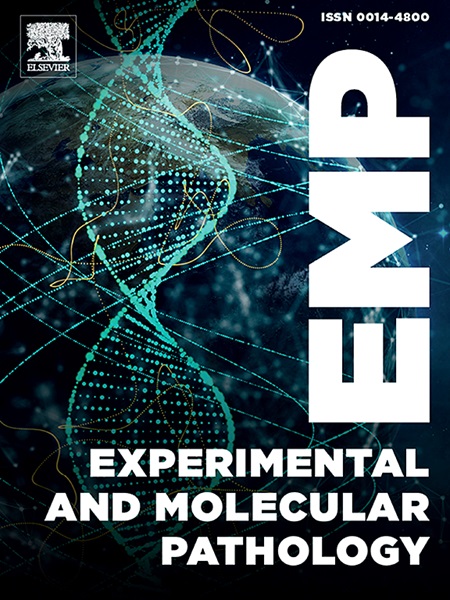Treatment with YKL-05-099, a salt inducible kinase (SIK) inhibitor, attenuates salt-sensitive hypertension: The molecular outcomes of SIK in the kidney
IF 3.7
4区 医学
Q2 PATHOLOGY
引用次数: 0
Abstract
Salt-inducible kinase (SIK) is a serine/threonine kinase that acts as an intracellular Na+ sensor, playing a role in salt-sensitive hypertension. We aimed to evaluate the therapeutic potential of YKL-05-099, a selective SIK inhibitor, in protecting kidney function and attenuating salt-sensitive hypertension. Male adult C57BL/6 J mice were randomly assigned to either a normal sodium (0.5 % NaCl; NS) or high‑sodium diet (4 % NaCl; HS) and further divided into two subgroups – receiving either intraperitoneal injection of saline or SIK inhibitor (SIKi; YKL-05-099, 20 mg/Kg/day). Blood pressure was measured by radiotelemetry for 15 days. On days 7 and 14, mice were placed in metabolic cages for 24 h urine collection. At the end of the treatment, blood and kidneys were collected for renal function assessment, and the renal cortex was extracted for biochemical analysis. HS intake led to a salt-sensitive hypertension model, as seen by increased systolic blood pressure (SPB), kidney damage and impairment in renal function. In the HS, SIKi treatment blocked the elevated SIK activity in the renal cortex, preventing kidney damage, proteinuria, and increased SBP. The Na+ balance was positive due, partly, to a higher (Na++K+)-ATPase activity in the HS. SIKi treatment exerted an anti-inflammatory effect by attenuating HS-dependent macrophage infiltration and ROS production and decreasing the metalloprotease activity. Consequently, the kidney damage biomarker monocyte chemotactic protein type 1 excretion was enhanced. In conclusion, SIK inhibition rescued HS mice from salt-sensitive hypertension and kidney insufficiency by blocking inflammation, metalloprotease activity, and oxidative stress.
Significance
Salt-sensitive hypertension is a major contributor to chronic kidney disease and cardiovascular morbidity worldwide. Despite its prevalence, the underlying mechanisms linking high salt intake to renal injury remain incompletely understood, and targeted therapies are lacking. This study identifies salt-inducible kinase (SIK) as a key mediator of salt-induced renal dysfunction and systemic hypertension. By using a selective SIK inhibitor (YKL-05-099), we demonstrate that pharmacological inhibition of SIK effectively prevents kidney damage, inflammation, oxidative stress, and high blood pressure in a preclinical model of salt-sensitive hypertension. These findings highlight SIK as a promising therapeutic target for preserving renal function and managing salt-induced hypertension, paving the way for novel interventions in salt-related cardiovascular and renal diseases.
盐诱导激酶(SIK)抑制剂YKL-05-099治疗可减轻盐敏感性高血压:SIK在肾脏中的分子结局
盐诱导激酶(SIK)是一种丝氨酸/苏氨酸激酶,作为细胞内Na+传感器,在盐敏感性高血压中发挥作用。我们旨在评估选择性SIK抑制剂YKL-05-099在保护肾功能和减轻盐敏感性高血压方面的治疗潜力。雄性成年C57BL/ 6j小鼠被随机分配到正常钠(0.5% NaCl;NS)或高钠饮食(4% NaCl;HS),并进一步分为两个亚组-接受腹腔注射生理盐水或SIK抑制剂(SIKi;YKL-05-099, 20 mg/Kg/天)。用无线电遥测法测量血压15天。在第7天和第14天,将小鼠置于代谢笼中收集24 h尿液。治疗结束时,取血、取肾评估肾功能,提取肾皮质进行生化分析。HS摄入导致盐敏感型高血压模型,收缩压(SPB)升高,肾损害和肾功能损害。在HS中,SIKi治疗阻断了肾皮质SIK活性升高,防止肾脏损伤、蛋白尿和收缩压升高。Na+平衡是正的,部分原因是HS中较高的(Na++K+)- atp酶活性。SIKi治疗通过降低hs依赖性巨噬细胞浸润和ROS产生,降低金属蛋白酶活性发挥抗炎作用。因此,肾脏损伤生物标志物单核细胞趋化蛋白1型排泄增加。综上所述,SIK抑制可通过抑制炎症、金属蛋白酶活性和氧化应激,使HS小鼠免于盐敏感性高血压和肾功能不全。在世界范围内,盐敏感性高血压是慢性肾脏疾病和心血管疾病的主要致病因素。尽管它很普遍,但高盐摄入与肾损伤之间的潜在机制仍然不完全清楚,而且缺乏靶向治疗。本研究确定盐诱导激酶(SIK)是盐诱导肾功能障碍和全身性高血压的关键介质。通过使用选择性SIK抑制剂(YKL-05-099),我们在盐敏感性高血压的临床前模型中证明了SIK的药理抑制能有效预防肾损害、炎症、氧化应激和高血压。这些发现强调了SIK作为一个有希望的治疗靶点,可以保护肾功能和控制盐性高血压,为盐相关心血管和肾脏疾病的新干预铺平了道路。
本文章由计算机程序翻译,如有差异,请以英文原文为准。
求助全文
约1分钟内获得全文
求助全文
来源期刊
CiteScore
8.90
自引率
0.00%
发文量
78
审稿时长
11.5 weeks
期刊介绍:
Under new editorial leadership, Experimental and Molecular Pathology presents original articles on disease processes in relation to structural and biochemical alterations in mammalian tissues and fluids and on the application of newer techniques of molecular biology to problems of pathology in humans and other animals. The journal also publishes selected interpretive synthesis reviews by bench level investigators working at the "cutting edge" of contemporary research in pathology. In addition, special thematic issues present original research reports that unravel some of Nature''s most jealously guarded secrets on the pathologic basis of disease.
Research Areas include: Stem cells; Neoangiogenesis; Molecular diagnostics; Polymerase chain reaction; In situ hybridization; DNA sequencing; Cell receptors; Carcinogenesis; Pathobiology of neoplasia; Complex infectious diseases; Transplantation; Cytokines; Flow cytomeric analysis; Inflammation; Cellular injury; Immunology and hypersensitivity; Athersclerosis.

 求助内容:
求助内容: 应助结果提醒方式:
应助结果提醒方式:


